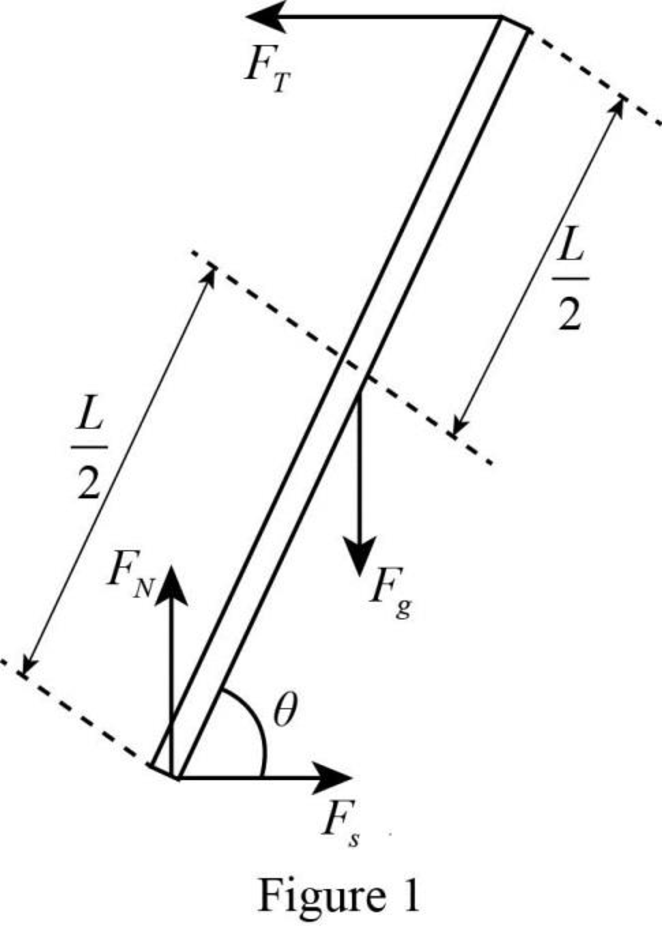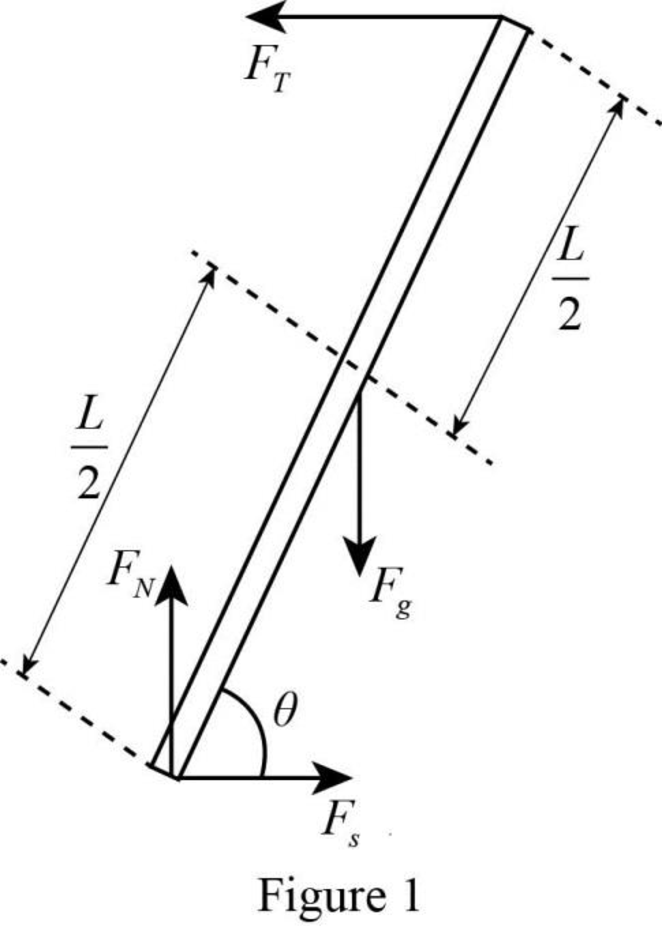
Concept explainers
(a)
The free-body diagram of the forces acting on the ladder.
(a)
Answer to Problem 82PQ
The free-body diagram of the forces acting on the ladder is

Explanation of Solution
A free-body diagram is a graphical tool used to illustrate the different forces acting on a particular object. It helps to solve complex physical problems. The free-body diagram of the ladder in the given situation is drawn in figure 1.

The forces acting on the ladder are the weight, the normal force, the tension and the force of static friction. In the figure weight is represented as
Conclusion:
Thus, the free-body diagram of the forces acting on the ladder is drawn in figure 1.
(b)
The tension in the rope in terms of
(b)
Answer to Problem 82PQ
The tension in the rope in terms of
Explanation of Solution
Take the lower end of the ladder as the pivot point. This will eliminate the torque due to normal force and the torque due to force of static friction.
Since the ladder is in rotational equilibrium, the net torque about the lower end of the ladder must be zero.
Write the condition for the rotational equilibrium.
Here,
Write the equation for
Here,
Put the above equation in equation (I).
Write the expression for
Write the expression for
Write the expression for
Here,
Write the expression for
Here,
Put the above four equations in equation (II) and rewrite it for
Conclusion:
Therefore, the tension in the rope in terms of
(c)
The expression for the tension in the rope in terms of
(c)
Answer to Problem 82PQ
The expression for the tension in the rope in terms of
Explanation of Solution
Since the ladder is in translational equilibrium, the net force in
Write the conditions for the translational equilibrium.
Here,
Here,
Write the equation for
Here,
Write the equation for
Here,
Put the above equation in equation (VI).
Put the above equation in equation (IV) and rewrite it for
Write the equation for
Here,
Write the equation for
Put the above equation in equation (VIII).
Put the above equation in equation (V) and rewrite it for
Put the above equation in equation (VII).
Conclusion:
Therefore, the expression for the tension in the rope in terms of
(d)
The coefficient of static friction in terms of the angle
(d)
Answer to Problem 82PQ
The coefficient of static friction in terms of the angle
Explanation of Solution
Equate equations (III) and (IX).
Conclusion:
Therefore, the coefficient of static friction in terms of the angle
(e)
The after effect of moving the ladder slightly so as to reduce the angle
(e)
Answer to Problem 82PQ
The ladder will slip if it is moved slightly to reduce the angle
Explanation of Solution
The expression for the angle
The expression for the tension force obtained in part (b),
Conclusion:
Thus, the ladder will slip if it is moved slightly to reduce the angle
Want to see more full solutions like this?
Chapter 14 Solutions
Physics for Scientists and Engineers: Foundations and Connections
- Consider a nanotube with a Youngs modulus of 2.130 1012 N/m2 that experiences a tensile stress of 5.3 1010 N/m2. Steel has a Youngs modulus of about 2.000 1011 Pa. How much stress would cause a piece of steel to experience the same strain as the nanotube?arrow_forwardA 500-N uniform rectangular sign 4.00 m wide and 3.00 m high is suspended from a horizontal, 6.00-m-long, uniform. 100-N rod as indicated in Figure P12.47. The left end of the rod is supported by a hinge, and the right end is supported by a thin cable making a 30.0 angle with the vertical. (a) Find the tension T in the cable. (b) Find the horizontal and vertical components of force exerted on the left end of the rod by the hinge. Figure P12.47arrow_forwardThree forces are exerted on the disk shown in Figure P12.71,and their magnitudes are F3 = 2F2 = 2F1. The disks outer rimhas radius R, and the inner rim has radius R/2. As shown in thefigure, F1 and F3 are tangent to the outer rim of the disk, and F2 is tangent to the inner rim. F3 is parallel to the x axis, F2 is parallel to the y axis, and F1 makes a 45 angle with the negative x axis. Find expressions for the magnitude of each torque exertedaround the center of the disk in terms of R and F1. FIGURE P12.71 Problems 71-75arrow_forward
- A stepladder of negligible weight is constructed as shown in Figure P12.40, with AC = BC = . A painter of mass m stands on the ladder a distance d from the bottom. Assuming the floor is frictionless, find (a) the tension in the horizontal bar DE connecting the two halves of the ladder, (b) the normal forces at A and B, and (c) the components of the reaction force at the single hinge C that the left half of the ladder exerts on the right half. Suggestion: Treat the ladder as a single object, but also treat each half of the ladder separately. Figure P12.40 Problems 40 and 41.arrow_forwardA 215-kg robotic arm at an assembly plant is extended horizontally (Fig. P14.32). The massless support rope attached at point B makes an angle of 15.0 with the horizontal, and the center of mass of the arm is at point C. a. What is the tension in the support rope? b. What are the magnitude and direction of the force exerted by the hinge A on the robotic arm to keep the arm in the horizontal position? FIGURE P14.32arrow_forwardA massless, horizontal beam of length L and a massless rope support a sign of mass m (Fig. P14.78). a. What is the tension in the rope? b. In terms of m, g, d, L, and , what are the components of the force exerted by the beam on the wall? FIGURE P14.78arrow_forward
- Why is the following situation impossible? A uniform beam of mass mk = 3.00 kg and length = 1.00 m supports blocks with masses m1 = 5.00 kg and m2 = 15.0 kg at two positions as shown in Figure P12.2. The beam rests on two triangular blocks, with point P a distance d = 0.300 m to the right of the center of gravity of the beam. The position of the object of mass m2 is adjusted along the length of the beam until the normal force on the beam at O is zero. Figure P12.2arrow_forwardAt a museum, a 1300-kg model aircraft is hung from a lightweight beam of length 12.0 m that is free to pivot about its base and is supported by a massless cable (Fig. P14.38). Ignore the mass of the beam. a. What is the tension in the section of the cable between the beam and the wall? b. What are the horizontal and vertical forces that the pivot exerts on the beam? FIGURE P14.38 (a) From the free-body diagram, the angle that the string tension makes with the beam is = 55.0 + 18.0 = 73.0, and the perpendicular component of the string tension is FT sin73.0. Summing torques around the base of the rod gives (Eq. 14.2): =0:(12.0m)(1300kg)(9.81m/s2)cos55.0+FT(12.0m)sin73.0=0FT=(12.0m)(1300kg)(9.81m/s2)cos55.0(12.0m)sin73.0FT=7.65103N Figure P14.38ANS (b) Using force balance (Eq. 14.1): Fx=0:FHFTcos18.0=0FH=FTcos18.0=[(12.0m)(1300kg)(9.81m/s2)cos55.0(12.0m)sin73.0]cos18.0=7.27103NFy=0:FVFTsin18.0(1300kg)(9.81m/s2)=0 FV=FTsin18.0+(1300kg)gFV=[(12.0m)(1300kg)(9.81m/s2)cos55.0(12.0m)sin73.0]sin18.0+(1300kg)(9.81m/s2)FV=1.51104Narrow_forwardA bridge of length 50.0 m and mass 8.00 104 kg is supported on a smooth pier at each end as shown in Figure P12.25. A truck of mass 3.00 104 kg is located 15.0 m from one end. What are the forces on the bridge at the points of support? Figure P12.25arrow_forward
- A square plate with sides of length 4.0 m can rotate about an axle passing through its center of mass and perpendicular to the plate as shown in Figure P14.36. There are four forces acting on the plate at different points. The rotational inertia of the plate is 24 kgm2. Is the plate in equilibrium? FIGURE P14.36arrow_forwardProblems 33 and 34 are paired. One end of a uniform beam that weighs 2.80 102 N is attached to a wall with a hinge pin. The other end is supported by a cable making the angles shown in Figure P14.33. Find the tension in the cable. FIGURE P14.33 Problems 33 and 34.arrow_forwardA horizontal, rigid bar of negligible weight is fixed against a vertical wall at one end and supported by a vertical string at the other end. The bar has a length of 50.0 cm and is used to support a hanging block of weight 400.0 N from a point 30.0 cm from the wall as shown in Figure P14.81. The string is made from a material with a tensile strength of 1.2 108 N/m2. Determine the largest diameter of the string for which it would still break. FIGURE P14.81arrow_forward
 Physics for Scientists and EngineersPhysicsISBN:9781337553278Author:Raymond A. Serway, John W. JewettPublisher:Cengage Learning
Physics for Scientists and EngineersPhysicsISBN:9781337553278Author:Raymond A. Serway, John W. JewettPublisher:Cengage Learning Physics for Scientists and Engineers with Modern ...PhysicsISBN:9781337553292Author:Raymond A. Serway, John W. JewettPublisher:Cengage Learning
Physics for Scientists and Engineers with Modern ...PhysicsISBN:9781337553292Author:Raymond A. Serway, John W. JewettPublisher:Cengage Learning Physics for Scientists and Engineers: Foundations...PhysicsISBN:9781133939146Author:Katz, Debora M.Publisher:Cengage Learning
Physics for Scientists and Engineers: Foundations...PhysicsISBN:9781133939146Author:Katz, Debora M.Publisher:Cengage Learning


